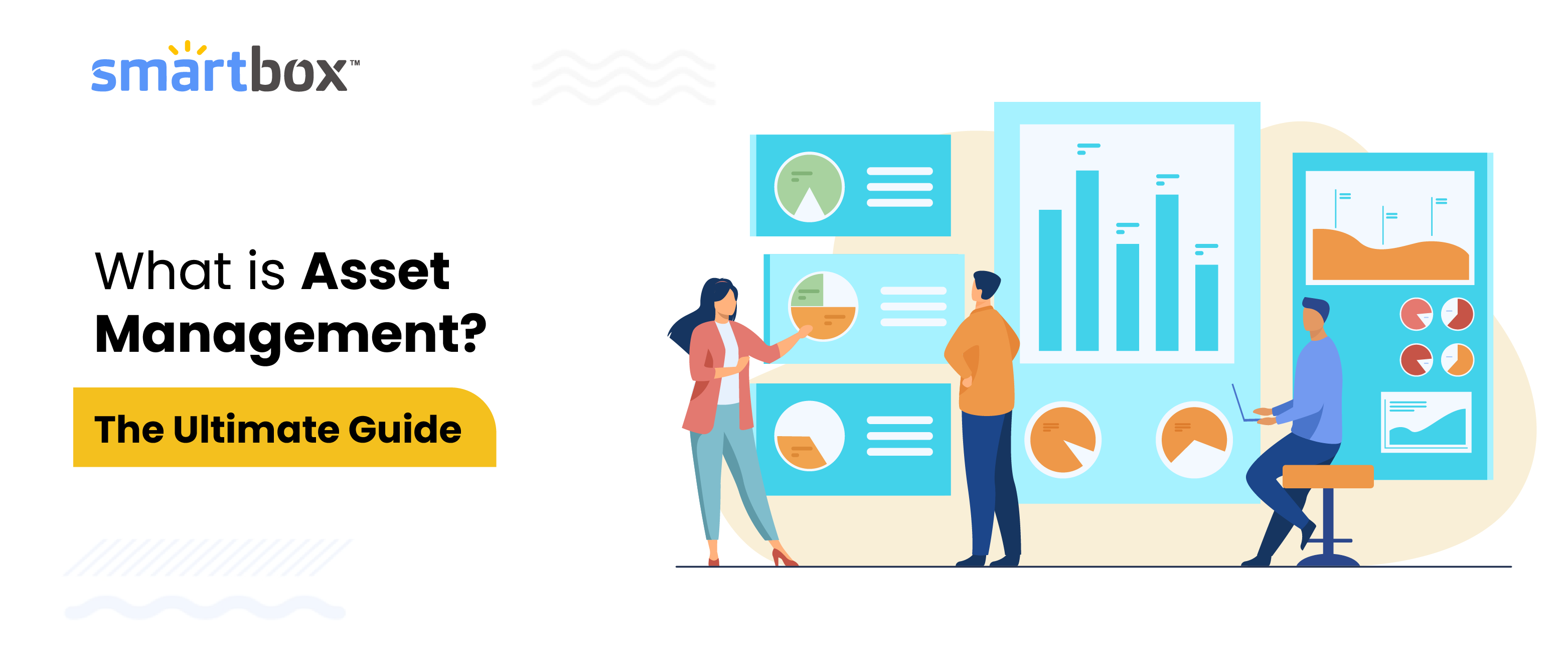The current business landscape is dynamic and ever changing. This calls for managing assets efficiently so that they can lead to achieving sustainable growth and success. Whether you’re a business owner, a project manager, or an investor, understanding asset management and its best practices can empower you to make informed decisions that optimize the performance of your organization.
This guide will provide you with the knowledge you need to understand asset management as an influential practice for greater business accomplishments. You will also explore the types, principles, examples, benefits, and importance of it.

Asset management goes beyond mere inventory tracking. It involves a strategic approach to handle a wide array of resources ranging from physical equipment, financial investments, and intellectual property. This comprehensive guide will delve into the core concepts of asset management, exploring its principles, key functions, and the vital role it plays in various industries.
What is Asset Management?
Asset management is the process of efficiently handling and overseeing valuable resources, such as property, equipment, belongings, and investments to improve their management and ensure their safekeeping.
The management of assets has become a pivotal factor for organizations aiming to achieve continuous growth and financial success. From company asset management to personal asset management, businesses and individuals alike seek effective ways to safeguard and optimize their valuable resources. This quest for streamlined asset management has given rise to innovative solutions, with asset management lockers emerging as a game-changer.
What are the Principles of Asset Management?
The principles of asset management focus on effective management and oversight of valuable resources to optimize their performance and ensure their safekeeping. By adhering to these principles, businesses can improve operational efficiency, reduce downtime, and make informed decisions.
There are 4 principles of asset management:
- Asset Identification and Categorization
- Asset Tracking and Documentation
- Maintenance and Risk Management
- Decisions based on Asset Data
- Asset Identification and Categorization
Asset Identification and Categorization
This involves establishing a systematic approach to identify and categorize assets. When successful, this principle ensures a clear understanding of what assets are owned and how they are utilized within the organization.
Pro Tip: Smart asset management lockers provide an intuitive solution for asset storage and categorization, ensuring each item is precisely accounted for and is easily accessible.
Asset Tracking and Documentation
This emphasizes the importance of thorough asset tracking and documentation. By maintaining detailed records, businesses can easily monitor asset movements, usage, and maintenance history.
Pro Tip: Asset management lockers offer real-time updates on asset movement and usage. With detailed tracking and documentation, businesses gain full visibility of their assets, reducing the risk of loss or mismanagement.
Maintenance and Risk Management
Regular maintenance and risk management are essential to extend the lifespan of assets and minimize unexpected breakdowns. By implementing proactive measures, businesses can mitigate potential risks and prevent costly disruptions.
Pro Tip: Smart lockers can be integrated with predictive maintenance tools, alerting businesses to potential issues and enabling proactive measures to prevent costly downtime.
Decisions based on Asset Data
Businesses must leverage data insights to make informed decisions regarding asset allocation, maintenance schedules, and overall asset management strategies.
Pro Tip: Smart lockers offer valuable data insights on asset usage patterns, allowing businesses to make informed decisions on optimizing asset allocation and streamlining operations.
What are the Roles and Key Functions of Asset Management?
For successful asset management functions, it is important that different elements align and work in harmony. All these elements plays a pivotal role in overseeing and optimizing valuable resources like physical assets, financial investments, and intellectual property. There are various functions of asset management that work together to optimize the performance, maintenance, and utilization of valuable resources within an organization. These key functions ensure that assets are well-managed throughout their entire lifecycle, from acquisition to disposal.
The key functions of asset management are:
- Procurement and Acquisition
- Tracking and Inventory Management
- Maintenance and Upkeep
- Depreciation and Value Assessment
- Disposal and Replacement Strategies
- Risk Management and Compliance
Procurement and Acquisition
Asset management asks for strategic acquisition of assets that are required to support the organization’s operations. This process entails careful planning, budgeting, and procurement to ensure that the assets align with the organization’s goals. The businesses must consider factors such as cost, quality, and reliability to make informed decisions during this process.
Tracking and Inventory Management
After asset acquisition, it is crucial to maintain a comprehensive inventory and track their movements throughout the organization. Asset tracking systems such as asset management lockers help monitor asset locations, usage patterns, and maintenance history. Proper tracking enables better control over asset distribution and ensures that assets are utilized efficiently.
Maintenance and Upkeep
Regular maintenance is essential to keep assets in optimal condition and extend their lifespan. Organizations must establish preventive maintenance schedules, conduct inspections, and address any issues promptly to minimize downtime and ensure the assets’ reliability. This can be done using asset management professionals, asset management lockers or other technological integrations.
Depreciation and Value Assessment
Assets, especially those with a limited useful life, depreciate over time. The organizations must keep an eye on asset depreciation and monitor their current value. This function helps determine the remaining value of assets and make informed decisions regarding replacements or upgrades.
Disposal and Replacement Strategies
As assets reach the end of their useful life or become obsolete, proper disposal or replacement strategies must be implemented. Responsible asset disposal, including recycling or selling, is essential to comply with environmental regulations. Additionally, organizations must plan for timely replacements to ensure that outdated assets do not hinder operations.
Risk Management and Compliance
Asset management involves identifying and mitigating risks associated with asset usage, maintenance, and disposal. This function ensures that all assets are following relevant regulations and safety standards, safeguarding the organization against potential liabilities.
Asset Management – Types, Examples, Importance, and Benefits
Asset management is a comprehensive practice that encompasses the efficient management and optimization of an organization’s valuable resources. These resources can include physical assets, financial investments, intellectual property, and more. Following are the several types, example, and benefits of asset management for businesses.
Types of Asset Management
Financial Asset Management: This type of asset management focuses on managing an organization’s financial investments, such as stocks, bonds, and mutual funds. Financial asset managers analyze market trends, diversify portfolios, and make informed investment decisions to maximize returns and mitigate risks.
Physical Asset Management: Physical asset management involves overseeing tangible assets like machinery, equipment, vehicles, and real estate. Asset managers in this category monitor asset performance, schedule maintenance, and make decisions regarding asset replacements or upgrades.
Infrastructure Asset Management: Infrastructure asset management deals with managing large-scale infrastructure assets, including bridges, roads, pipelines, and utility systems. It entails maintaining and improving these assets to ensure safety, reliability, and cost-effectiveness.
Information Technology Asset Management (ITAM): ITAM involves managing an organization’s IT assets, such as hardware, software, and network resources. IT asset managers ensure license compliance, optimize software usage, and plan for technology refresh cycles. This is where asset management lockers perform the best.
Intellectual Property Asset Management: Intellectual property assets like patents, trademarks, and copyrights are managed to protect the organization’s valuable intangible assets and ensure their proper usage.
Examples of Asset Management
Investment Portfolio Management: Asset management professional in this type oversees a diverse investment portfolio for a client, making strategic decisions to balance risk and return for the business.
Fleet Management: Professional fleet managers of a company ensure efficient use, maintenance, and replacement of vehicles to support smooth operations and reduce transportation costs.
Facility Management: A facility manager is responsible for the maintenance and optimization of a building’s physical assets, ensuring a safe and productive working environment.
Software Asset Management: An IT asset manager tracks software licenses, monitors software installations, and ensures compliance with licensing agreements.
Real Estate Asset Management: A real estate asset manager manages a portfolio of properties, making decisions regarding acquisitions, maintenance, and lease agreements.
Pro Tip: Smart lockers for asset management are pioneering in all types of asset management where different professionals can reap the fruits of lockers for asset management.
Importance of Asset Management
Effective asset management holds significant importance for businesses to:
- Maximize resource utilization and minimize wastage.
- Enhance operational efficiency and reduce downtime.
- Mitigate risks associated with asset ownership and maintenance.
- Ensure compliance with industry regulations and standards.
- Facilitate data-driven decision-making for strategic planning.
Benefits of Asset Management
Just like any other fundamental, asset management also helps business in various domains. These are some of the most noticeable benefits of asset management.
Cost Savings: Optimized asset utilization reduces unnecessary expenses and improves asset lifespan, resulting in cost savings. By focusing on the most essential elements that need investment, businesses can save their overall expense.
Improved Efficiency: Streamlined asset management processes lead to enhanced operational efficiency and productivity. With better efficiency, businesses can turn their focus towards other areas that may require upgradation.
Risk Mitigation: Proactive maintenance and monitoring reduce the risk of asset failure and unplanned downtime. Businesses can avoid losing their assets with timely maintenance and monitoring.
Data Tracking: Asset management provides valuable data insights to inform strategic decisions and future planning. Data provides real-time information that can be capitalized to make further enhancements in the overall business success plan.
Enhanced Reputation: Proper asset management displays responsible business practices, boosting stakeholder confidence and reputation. When the maintenance of assets is increased and the issues with them decreases, the reputation of a business flourishes.
Conclusion
Asset management is a vital practice that optimizes the utilization, tracking, and maintenance of valuable resources for businesses. By adhering to the principles of asset identification, tracking, and proactive maintenance, organizations can enhance efficiency, reduce downtime, and make informed decisions based on data insights.
Asset Management asks for technological innovation that helps streamline and speed up the overall operations. This can help businesses take decisions based on the actual data enabling them to stay competitive and meet the evolving needs of their users.
With that being said, we bid adieu for now. Till then – Stay ahead of the curve with our comprehensive insights and analysis!
Don't forget to share this post!




